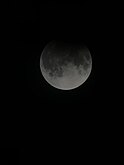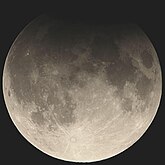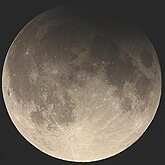| Partial eclipse | |||||||||||||
 Maximum partiality, 2:44 UTC, from Minneapolis, Minnesota Maximum partiality, 2:44 UTC, from Minneapolis, Minnesota | |||||||||||||
| Date | September 18, 2024 | ||||||||||||
|---|---|---|---|---|---|---|---|---|---|---|---|---|---|
| Gamma | −0.9792 | ||||||||||||
| Magnitude | 0.0869 | ||||||||||||
| Saros cycle | 118 (52 of 73) | ||||||||||||
| Partiality | 62 minutes, 49 seconds | ||||||||||||
| Penumbral | 246 minutes, 22 seconds | ||||||||||||
| |||||||||||||
| ← March 2024March 2025 → | |||||||||||||
| External videos | |
|---|---|
A partial lunar eclipse occurred at the Moon’s ascending node of orbit on Wednesday, September 18, 2024, with an umbral magnitude of 0.0869. A lunar eclipse occurs when the Moon moves into the Earth's shadow, causing the Moon to be darkened. A partial lunar eclipse occurs when one part of the Moon is in the Earth's umbra, while the other part is in the Earth's penumbra. Unlike a solar eclipse, which can only be viewed from a relatively small area of the world, a lunar eclipse may be viewed from anywhere on the night side of Earth. Occurring only about 7 hours before perigee (on September 18, 2024, at 9:20 UTC), the Moon's apparent diameter was larger. This eclipse also occurred during a supermoon.
This eclipse was the final partial lunar eclipse of Lunar Saros 118.
Visibility
The eclipse was completely visible over North and South America, west Africa, and western Europe, seen rising over western North America and the eastern Pacific Ocean and setting over east Africa, eastern Europe, and west and central Asia.
 
|
 Visibility map |
Gallery
-
 33 minutes after Penumbra Phase started, Halifax, Canada, 01:14 UTC
33 minutes after Penumbra Phase started, Halifax, Canada, 01:14 UTC
-
 From Halifax, Canada, (Maximum) 02:44 UTC
From Halifax, Canada, (Maximum) 02:44 UTC
-
 From Halifax, Canada, 02:41 UTC
From Halifax, Canada, 02:41 UTC
-
 End of Partially, Halifax, Canada, 03:11 UTC
End of Partially, Halifax, Canada, 03:11 UTC
-
 September 2024 Lunar Eclipse from Mexicali, 2:49 UTC, Mexicali, Mexico
September 2024 Lunar Eclipse from Mexicali, 2:49 UTC, Mexicali, Mexico
-
 Start of partial eclipse in Moscow, Russia, 02:19 UTC
Start of partial eclipse in Moscow, Russia, 02:19 UTC
-
 From Moscow, 02:45 UTC
From Moscow, 02:45 UTC
-
 Near sunrise, Moscow, 02:55 UTC
Near sunrise, Moscow, 02:55 UTC
-
 From Dallas, Texas
From Dallas, Texas
-
 From Logroño, Spain, 02:50 UTC
From Logroño, Spain, 02:50 UTC
-
 1:46 UTC, Minnesota, USA
1:46 UTC, Minnesota, USA
-
 2:28 UTC, Minnesota, USA
2:28 UTC, Minnesota, USA
-
 2:44 UTC (maximum), Minnesota, USA
2:44 UTC (maximum), Minnesota, USA
-
 02:46 UTC, Santa Ana, California, USA
02:46 UTC, Santa Ana, California, USA
-
 2:49 UTC, Norwalk Ohio, USA
2:49 UTC, Norwalk Ohio, USA
-
 3:01 UTC, Minnesota, USA
3:01 UTC, Minnesota, USA
-
 3:16 UTC, Minnesota, USA
3:16 UTC, Minnesota, USA
Eclipse details
Shown below is a table displaying details about this particular solar eclipse. It describes various parameters pertaining to this eclipse.
| Parameter | Value |
|---|---|
| Penumbral Magnitude | 1.03922 |
| Umbral Magnitude | 0.08685 |
| Gamma | −0.97920 |
| Sun Right Ascension | 11h44m09.7s |
| Sun Declination | +01°42'52.9" |
| Sun Semi-Diameter | 15'55.1" |
| Sun Equatorial Horizontal Parallax | 08.8" |
| Moon Right Ascension | 23h46m06.1s |
| Moon Declination | -02°35'26.7" |
| Moon Semi-Diameter | 16'42.8" |
| Moon Equatorial Horizontal Parallax | 1°01'20.4" |
| ΔT | 71.5 s |
Eclipse season
See also: Eclipse cycleThis eclipse is part of an eclipse season, a period, roughly every six months, when eclipses occur. Only two (or occasionally three) eclipse seasons occur each year, and each season lasts about 35 days and repeats just short of six months (173 days) later; thus two full eclipse seasons always occur each year. Either two or three eclipses happen each eclipse season. In the sequence below, each eclipse is separated by a fortnight.
| September 18 Ascending node (full moon) |
October 2 Descending node (new moon) |
|---|---|
 |

|
| Partial lunar eclipse Lunar Saros 118 |
Annular solar eclipse Solar Saros 144 |
Related eclipses
Eclipses in 2024
- A penumbral lunar eclipse on March 25.
- A total solar eclipse on April 8.
- A partial lunar eclipse on September 18.
- An annular solar eclipse on October 2.
Metonic
- Preceded by: Lunar eclipse of November 30, 2020
- Followed by: Lunar eclipse of July 6, 2028
Tzolkinex
- Preceded by: Lunar eclipse of August 7, 2017
- Followed by: Lunar eclipse of October 30, 2031
Half-Saros
- Preceded by: Solar eclipse of September 13, 2015
- Followed by: Solar eclipse of September 23, 2033
Tritos
- Preceded by: Lunar eclipse of October 18, 2013
- Followed by: Lunar eclipse of August 19, 2035
Lunar Saros 118
- Preceded by: Lunar eclipse of September 7, 2006
- Followed by: Lunar eclipse of September 29, 2042
Inex
- Preceded by: Lunar eclipse of October 8, 1995
- Followed by: Lunar eclipse of August 29, 2053
Triad
- Preceded by: Lunar eclipse of November 18, 1937
- Followed by: Lunar eclipse of July 21, 2111
Lunar eclipses of 2024–2027
This eclipse is a member of a semester series. An eclipse in a semester series of lunar eclipses repeats approximately every 177 days and 4 hours (a semester) at alternating nodes of the Moon's orbit.
The penumbral lunar eclipse on July 18, 2027 occurs in the next lunar year eclipse set.
| Lunar eclipse series sets from 2024 to 2027 | ||||||||
|---|---|---|---|---|---|---|---|---|
| Descending node | Ascending node | |||||||
| Saros | Date Viewing |
Type Chart |
Gamma | Saros | Date Viewing |
Type Chart |
Gamma | |
113
|
2024 Mar 25
|
Penumbral
|
1.0610 | 118
|
2024 Sep 18
|
Partial
|
−0.9792 | |
| 123 | 2025 Mar 14
|
Total
|
0.3485 | 128 | 2025 Sep 07
|
Total
|
−0.2752 | |
| 133 | 2026 Mar 03
|
Total
|
−0.3765 | 138 | 2026 Aug 28
|
Partial
|
0.4964 | |
| 143 | 2027 Feb 20
|
Penumbral
|
−1.0480 | 148 | 2027 Aug 17
|
Penumbral
|
1.2797 | |
Saros 118
This eclipse is a part of Saros series 118, repeating every 18 years, 11 days, and containing 73 events. The series started with a penumbral lunar eclipse on March 2, 1105. It contains partial eclipses from June 8, 1267 through August 12, 1375; total eclipses from August 22, 1393 through June 22, 1880; and a second set of partial eclipses from July 3, 1898 through September 18, 2024. The series ends at member 73 as a penumbral eclipse on May 7, 2403.
The longest duration of totality was produced by member 37 at 99 minutes, 22 seconds on April 7, 1754. All eclipses in this series occur at the Moon’s ascending node of orbit.
| Greatest | First | |||
|---|---|---|---|---|
| The greatest eclipse of the series occurred on 1754 Apr 07, lasting 99 minutes, 22 seconds. | Penumbral | Partial | Total | Central |
| 1105 Mar 02 |
1267 Jun 08 |
1393 Aug 22 |
1465 Oct 04 | |
| Last | ||||
| Central | Total | Partial | Penumbral | |
| 1826 May 21 |
1880 Jun 22 |
2024 Sep 18
|
2403 May 07 | |
Eclipses are tabulated in three columns; every third eclipse in the same column is one exeligmos apart, so they all cast shadows over approximately the same parts of the Earth.
| Series members 40–61 occur between 1801 and 2200: | |||||
|---|---|---|---|---|---|
| 40 | 41 | 42 | |||
| 1808 May 10 | 1826 May 21 | 1844 May 31 | |||
| 43 | 44 | 45 | |||
| 1862 Jun 12 | 1880 Jun 22 | 1898 Jul 03 | |||
| 46 | 47 | 48 | |||
| 1916 Jul 15 | 1934 Jul 26 | 1952 Aug 05 | |||

|

|

|

|

|

|
| 49 | 50 | 51 | |||
| 1970 Aug 17 | 1988 Aug 27 | 2006 Sep 07 | |||

|

|

|

|

|

|
| 52 | 53 | 54 | |||
| 2024 Sep 18 | 2042 Sep 29 | 2060 Oct 09 | |||

|

|

|

|
||
| 55 | 56 | 57 | |||
| 2078 Oct 21 | 2096 Oct 31 | 2114 Nov 12 | |||
| 58 | 59 | 60 | |||
| 2132 Nov 23 | 2150 Dec 04 | 2168 Dec 14 | |||
| 61 | |||||
| 2186 Dec 26 | |||||
Tritos series
This eclipse is a part of a tritos cycle, repeating at alternating nodes every 135 synodic months (≈ 3986.63 days, or 11 years minus 1 month). Their appearance and longitude are irregular due to a lack of synchronization with the anomalistic month (period of perigee), but groupings of 3 tritos cycles (≈ 33 years minus 3 months) come close (≈ 434.044 anomalistic months), so eclipses are similar in these groupings.
| Series members between 1817 and 2200 | |||||||||
|---|---|---|---|---|---|---|---|---|---|
| 1817 May 01 (Saros 99) |
1828 Mar 31 (Saros 100) |
1839 Feb 28 (Saros 101) |
1850 Jan 28 (Saros 102) |
1860 Dec 28 (Saros 103) | |||||
| 1893 Sep 25 (Saros 106) |
1915 Jul 26 (Saros 108) | ||||||||

|

| ||||||||
| 1926 Jun 25 (Saros 109) |
1937 May 25 (Saros 110) |
1948 Apr 23 (Saros 111) |
1959 Mar 24 (Saros 112) |
1970 Feb 21 (Saros 113) | |||||

|

|

|

|

|

|

|

|

|

|
| 1981 Jan 20 (Saros 114) |
1991 Dec 21 (Saros 115) |
2002 Nov 20 (Saros 116) |
2013 Oct 18 (Saros 117) |
2024 Sep 18 (Saros 118) | |||||

|

|

|

|

|

|

|

|

|

|
| 2035 Aug 19 (Saros 119) |
2046 Jul 18 (Saros 120) |
2057 Jun 17 (Saros 121) |
2068 May 17 (Saros 122) |
2079 Apr 16 (Saros 123) | |||||

|

|

|

|

|

|

|

|
||
| 2090 Mar 15 (Saros 124) |
2101 Feb 14 (Saros 125) |
2112 Jan 14 (Saros 126) |
2122 Dec 13 (Saros 127) |
2133 Nov 12 (Saros 128) | |||||
| 2144 Oct 11 (Saros 129) |
2155 Sep 11 (Saros 130) |
2166 Aug 11 (Saros 131) |
2177 Jul 11 (Saros 132) |
2188 Jun 09 (Saros 133) | |||||
| 2199 May 10 (Saros 134) | |||||||||
Half-Saros cycle
A lunar eclipse will precede and follow by solar eclipses by 9 years and 5.5 days (a half saros). This lunar eclipse is related to two partial solar eclipses of Solar Saros 125.
| September 13, 2015 | September 23, 2033 |
|---|---|

|

|
See also
References
- "September 17–18, 2024 Partial Lunar Eclipse". timeanddate. Retrieved 18 November 2024.
- "Moon Distances for London, United Kingdom, England". timeanddate. Retrieved 18 November 2024.
- "Partial Lunar Eclipse of 2024 Sep 18" (PDF). NASA. Retrieved 18 November 2024.
- "Partial Lunar Eclipse of 2024 Sep 18". EclipseWise.com. Retrieved 18 November 2024.
- van Gent, R.H. "Solar- and Lunar-Eclipse Predictions from Antiquity to the Present". A Catalogue of Eclipse Cycles. Utrecht University. Retrieved 6 October 2018.
- "NASA - Catalog of Lunar Eclipses of Saros 118". eclipse.gsfc.nasa.gov.
- Listing of Eclipses of series 118
- Mathematical Astronomy Morsels, Jean Meeus, p.110, Chapter 18, The half-saros
External links
- Saros cycle 118
- 2024 Sep 18 chart: Eclipse Predictions by Fred Espenak, NASA/GSFC


